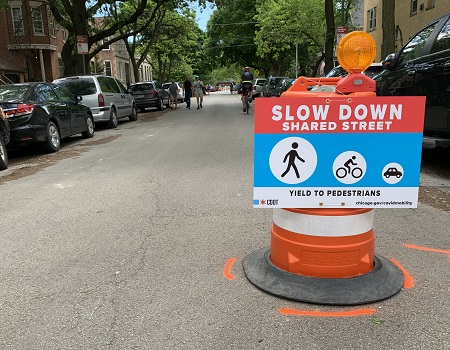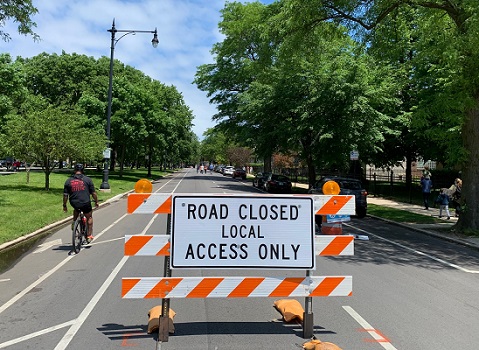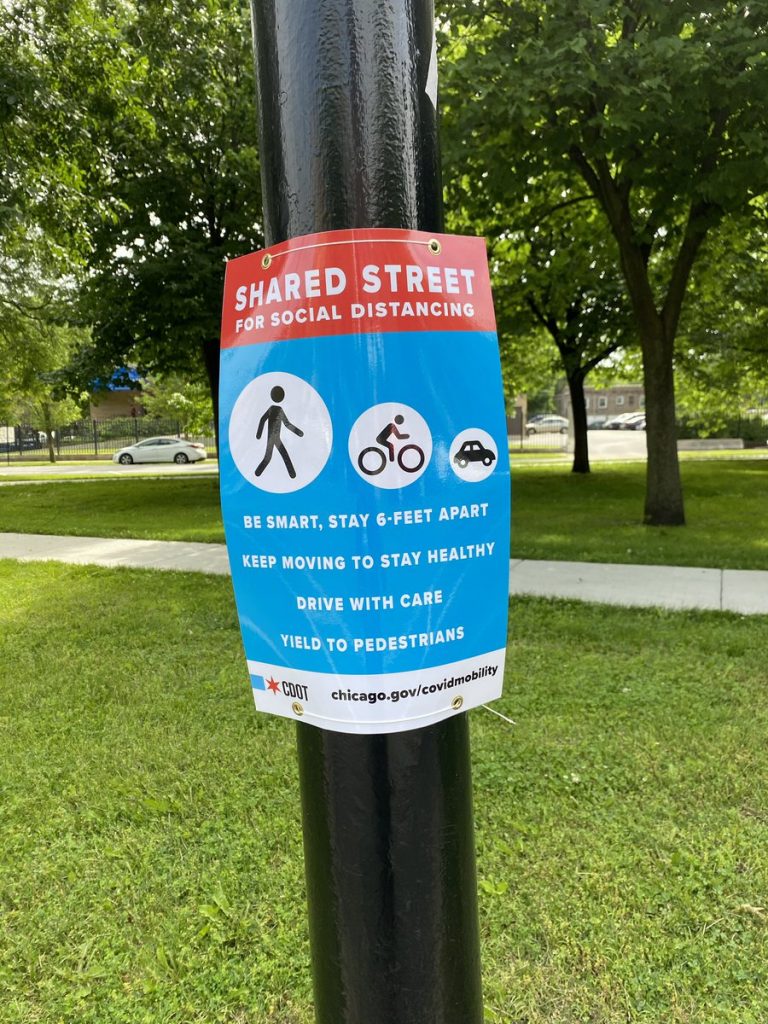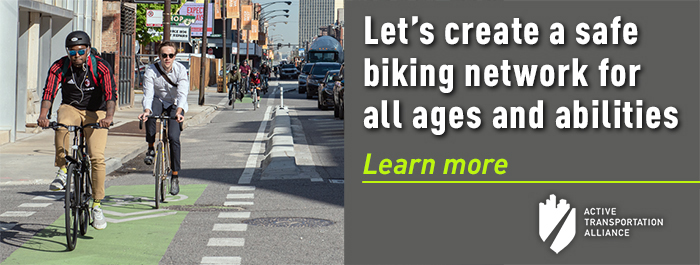Did You Know?
Shared streets program: looking back and looking ahead

Last summer, Chicago’s shared streets program provided opportunities for residents to safely spend time outside during the peak of the pandemic. While people appreciated the extra space for recreation and safely being outdoors, the program did little to address connectivity issues with the city’s walking and biking networks, according to feedback from Active Trans members and supporters.
Recently, the Chicago Department of Transportation (CDOT) announced that the Shared Streets program will continue in 2021 with $500,000 allocated towards 12 to 13 miles of shared streets. The program was first launched in 2020 in response to demand during the pandemic for safe places to walk and ride. (See a list of the 2020 shared streets in Chicago.)
Shared streets are intended to limit car and truck traffic with temporary infrastructure like construction barrels and signs to create safe spaces for people to walk and roll in the street.
As more of Chicago “reopens” with vaccination efforts, how do shared streets fit into the city? How should they be adapted when the social-distancing isn’t as crucial? Our survey sought to answer these important questions.
WHO RESPONDED TO THE SURVEY
We targeted organizations and residents close to the shared streets that were implemented in 2020. Our survey respondents were overwhelmingly in White communities on the North Side.
A large portion of the responses were related the Cortland and Leland shared streets. As a result, our survey results are far from representative of types of experiences people had with shared streets in Chicago.
Still, the 401 responses we received offer a useful snapshot of how shared streets helped and how, in some cases, they fell short. More outreach is needed to understand the impacts in other communities.
WHAT WE LEARNED
Overwhelmingly, respondents said they appreciated how the shared streets offered a recreational space to walk and bike. One respondent who used the Grace shared street said, “It created space for residents of the neighborhood to enjoy the outdoors safely without speeding and reckless cars.”
Few people viewed the shared streets as central transportation corridors. Instead, they saw them as a way to stay active close to home. One respondent who used the Cortland shared street said, “The shared street nearest to me seemed like a palliative gesture — it’s not a highly-trafficked street nor a corridor heavily relied upon to connect to services or transit. It was mostly for recreation.”
Others seemed confused as to the routes and where they led. One respondent who used the Palmer Street shared street said, “The beginning and end of the paths lead to nowhere. If you wanted to walk to Cicero, you ended up at a used car lot and an abandoned used car lot.”
Respondents also frequently said that the shared streets provided a safe place to socially-distance at the beginning of the pandemic. One respondent near the Leland shared street said, “I am an older adult as are several friends that live nearby. We all enjoyed walking with less cars and being able to social distance.”

HOW DID SHARED STREETS SERVE PEOPLE WHO ARE VULNERABLE OR MARGINALIZED?
When we asked if the shared streets program addressed the needs of essential workers, older adults, people with disabilities, marginalized populations, and other vulnerable groups, the responses were mixed. Here is some of what we heard in response to that question:
- During the pandemic specifically, it allowed a safer space for getting outside. However, safer and more accessible streets for overlooked groups, and all pedestrians in general, have always been a community need. (Dickens)
- It helped more seniors walk safely in the area. I also saw more people with disabilities out more frequently and more kids and families out walking. We live on Leland and while in some ways it was an inconvenience for us getting to our house when we were coming from longer trip in car, the overall benefits to the community are well worth it. (Leland)
- As an older disabled adult, I tried to avoid walking on the shared street on Palmer due to not feeling safe especially near Lorel Ave where it is two way. Cars and kids on bikes would not stop or let you walk on the shared street. (Palmer)
- As a senior, it gave me more room, especially to socially distance during the pandemic. (Leland)
HOW TO IMPROVE THE PROGRAM
We heard a variety of concerns about the 2020 program, including speeding cars, unclear signage, moved barriers, and general confusion about the program’s purpose. Here are suggestions for CDOT to help address these issues and improve this summer’s upcoming program.
Improve communication. Survey respondents felt information about the Shared Streets program did not reach enough people. There was a general lack of understanding of the program’s purpose, timeframe, and how to safely use the shared space.
More direct outreach is recommended in every neighborhood to better prepare residents for the 2021 roll-out, explain the program’s purpose, and solicit more direct feedback from each community. To additionally help drivers and rideshare companies understand the shared street locations, the program locations should be added to Google Maps and other navigation systems. This information may help drivers prepare to slow down when approaching the shared street or avoid it altogether.
Use clear signage. Several respondents reported cars speeding or driving aggressively through the pilot areas. Signage with larger fonts and images instructing drivers to proceed with care could help ensure a safer roll-out of the program.
A respondent who used the School Street pilot commented, “I noticed a lot of signage was 8.5 X 11 or slightly bigger and had a lot of text. While that was somewhat visible to those walking or biking, it was not helpful for drivers.”
Involve community partners. Respondents also commented that the cones and barriers were regularly removed from the street, leading to confusion among drivers, speeding, and safety concerns for people walking and biking. Others felt the barriers were an eyesore and did not fit the community’s character.
CDOT could work with community partners or local volunteers to act as stewards of the shared streets. These groups could talk to neighbors about the program, replace moved barriers and signage as needed, and help activate the space through programming, events, or artwork.
In Oakland, California, for example, the city worked with a local artist to build barricade planters and culturally-relevant signage that was a better fit for the neighborhood.

Reconsider program locations. Many respondents expressed frustration that the shared streets program did not help them get to where they needed to go. While the program initially provided much-needed recreational space and was appreciated where social distancing on the sidewalk was difficult, CDOT may want to reevaluate some of the shared street locations to help more people meet their needs and access destinations such as business centers, schools, parks, and grocery stores.
A user of the Cortland/Wabansia Street pilot recommends, “Future pilots should focus on paralleling major corridors, connecting centers and neighborhoods so everyone has a safe option not just for recreation but to get to jobs and essential services.” This is especially true as more destinations open and COVID protocols continue to loosen.
POST-PANDEMIC SOLUTIONS
When asked more broadly about what transportation improvements respondents would like to see in their community in 2021, the vast majority were interested in permanent infrastructure improvements, such as building protected bike lanes, building safer intersections with curb bump-outs, painted crosswalks, or traffic circles, repairing or building new sidewalks, or installing bus-only lanes to improve the speed and reliability of buses.
Both people who were in support of shared streets and opposed to them agreed that permanent infrastructure is needed in Chicago.

It is clear that people are eager for safer mobility options and a permanent network of infrastructure that makes them feel safe walking, biking, and taking transit. The Shared Streets program was a specific intervention to give space for social distancing and recreation in the midst of the pandemic, but the program does not fill gaps in transportation network to get more people walking, biking, and taking transit.
Active Trans continues to advocate for a recovery network of protected bike lanes and bus lanes as a way to promote freedom of movement and help get people where they need to go, especially in the highest need areas.
Recreation-oriented programs like shared streets are necessary to boost our physical and mental health, especially in the early stages of the pandemic when people struggled to safely spend time outdoors.
But in order to address the climate crisis and improve air quality, we need to reduce driving. That requires engineering improvements to major transportation corridors to make walking, biking, and transit safer and more convenient.
_____________________________________________
In addition to creating shared streets, Chicago needs more bike lanes that are safe and welcoming for all. Unfortunately, the city has fallen far behind its promises to build protected bike lanes. Click on the graphic below to learn more.
_____________________________________________
Active Trans is able to carry out its work thanks to support and donations from people like you. If you’re not a member of Active Trans, please join us. Already a member? Consider donating to ensure that this important work keeps moving forward.
Photos courtesy of the Chicago Department of Transportation
Make a Donation
Your tax-deductible donation supports the important work that Active Trans does throughout the region

